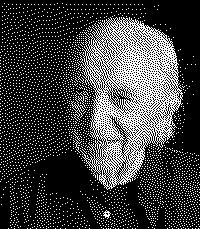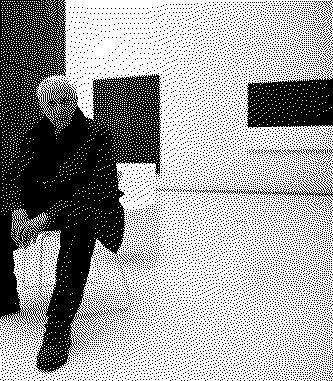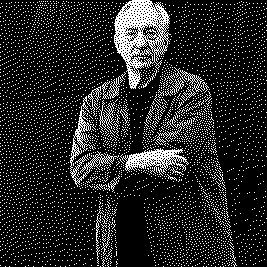Artists/Pierre Soulages
Fast Facts
Master of Light and Dark
Pierre Soulages is renowned for his extensive use of black, which he refers to as "noir-lumière" or "black light." He believes that black, far from being a color of darkness, can emit light and evoke a sense of depth and luminosity. His innovative use of black has made him one of the most celebrated abstract painters of the 20th and 21st centuries (The Art Story) (Gagosian).
Outrenoir Technique
Soulages developed a unique painting technique known as "outrenoir" or "beyond black." This method involves layering thick coats of black paint and manipulating their surfaces to reflect light in various ways, creating intricate textures and reflections. This technique has become a hallmark of his work, exploring the interplay between light and dark (Wikipedia) (The Art Story).
International Acclaim
Pierre Soulages has gained international recognition and his works are held in prestigious collections worldwide, including the Museum of Modern Art in New York, the Tate Gallery in London, and the Centre Pompidou in Paris. His influence extends beyond France, marking him as a global figure in contemporary art (Artnet News) (Gagosian).
Longevity in Art
Soulages has had an exceptionally long and productive career, spanning over seven decades. Even in his late 90s, he continued to work and innovate, demonstrating an enduring passion and commitment to his art. His longevity and sustained creativity are testaments to his significant impact on the art world (The Art Story) (Gagosian).
Recognition and Honors
Soulages has received numerous accolades for his contributions to art, including the Praemium Imperiale for painting, one of the highest honors in the art world. He has also been inducted into the French Legion of Honor, reflecting his status as a cultural icon in France and beyond (Wikipedia) (Artnet News).
Biography



Pierre Soulages, born on December 24, 1919, in Rodez, France, and passing on October 26, 2022, in Sète, France, was a monumental figure in postwar abstract art and a pioneer of the Tachism movement, the French equivalent of Action Painting in the United States. Soulages was distinguished by his unique approach to art, characterized by a profound engagement with the color black, which he explored through various methods throughout his career (Encyclopedia Britannica).
Soulages's early life in Rodez was marked by a fascination with Celtic carvings, prehistoric cave art, and the Romanesque architecture of the Sainte-Foy church at Conques. This deep-rooted interest in ancient and medieval art forms played a significant role in shaping his artistic vision. In 1938, he moved to Paris to pursue art studies, where he was exposed to the works of Pablo Picasso and Paul Cézanne and visited the Louvre. However, disillusioned by the traditional teachings of the École des Beaux-Arts, he left Paris, only to return later and immerse himself in painting, especially focusing on the stark contrasts of trees in winter. His participation in World War II was brief, and he spent much of the war working clandestinely on a vineyard to avoid forced labor under German occupation. During this period, his interaction with the Russian painter Sonia Delaunay introduced him to abstract art, significantly influencing his later work (Encyclopedia Britannica).
Soulages's career took a definitive turn in 1946 when he established a studio in Courbevoie, near Paris, and began producing abstract works marked by bold black brush strokes. His circle included prominent artists like Hans Hartung, Francis Picabia, and Fernand Léger. His first exhibition at the Salon des Surindépendants in 1947 marked the beginning of a storied career that saw his works being acquired by major museums across the globe, including the Phillips Collection and the Museum of Modern Art in New York City. His artistic style evolved over the years, becoming looser and more gestural in the 1950s and later focusing almost exclusively on the texture and brushwork of black paint on large canvases, a style he termed "outrenoir" or "beyond black" (Encyclopedia Britannica).
In the latter part of his career, Soulages undertook significant projects, including the creation of 104 stained-glass windows for the Abbey of Sainte-Foy in Conques between 1987 and 1994. This work reflected his ongoing exploration of light and its interaction with blackness, a theme central to his outrenoir paintings. Soulages was celebrated for his unique ability to capture the profound interplay of light and darkness, which he saw as fundamental to human experience. His contributions to art were recognized with exhibitions in prestigious venues such as the Hermitage Museum in St. Petersburg and the Tretyakov Gallery in Moscow. In 2007, the Musée Fabre in Montpellier dedicated a room to his work, and in 2014, the Musée Soulages in Rodez was opened, showcasing a comprehensive collection of his works across all stages of his career (Wikipedia).
Soulages's personal life was also of note. He met his wife, Colette Llaurens, while studying at the Fine Arts School of Montpellier, and the couple enjoyed a long and supportive partnership until his passing at the age of 102. Soulages's legacy is carried forward by collections of his work held in numerous museums worldwide and by the Musée Soulages, which stands as a testament to his enduring impact on the world of modern and contemporary art (Wikipedia).
Importance
Pierre Soulages' significance in the art world is multifaceted, highlighting his revolutionary role in modern and post-war abstract art. His contributions are recognized in several key aspects:
Pioneer of Post-War Abstract Movement and Tachism
Soulages is celebrated as a major figure in the post-war abstract movement, particularly in Tachism, the French counterpart to Action painting in the United States. His exploration of abstract expression through the restraint and depth of the color black has cemented his position as a leader in this artistic domain (Encyclopedia Britannica).
Artistic Autonomy and Exploration of Black
His pursuit of artistic autonomy is evident in his unique approach to painting, notably through his profound exploration of the color black, or "outrenoir" (beyond black). This exploration was not just an aesthetic choice but a profound inquiry into purity, prehistory, and the absence of connotation, reflecting a fascination with primal states of human existence and the transformative power of light reflecting off dark surfaces (Art in Context).
Global Recognition and Influence
Soulages' impact is underscored by his widespread recognition and influence, exemplified by exhibitions in prestigious venues worldwide, including the Venice Biennale and the Solomon R. Guggenheim Museum. His distinction as the first living artist to exhibit at the State Hermitage Museum in St. Petersburg further attests to his global stature (Art in Context).
Contribution to Cultural and Artistic Discourse
His work prompts critical discussions about the nature of representation, artistic autonomy, and the role of color and form in art. By focusing on process and materiality over narrative or representational content, Soulages challenges viewers to engage with art on a deeply introspective level, questioning the essence of artistic expression and the viewer's relationship with color and space (Art in Context).
Innovation in Technique and Style
Soulages' technique and style, characterized by bold, gestural mark-making and a profound depth of color, have made significant contributions to the evolution of abstract art. His use of unconventional tools and approaches to applying paint has expanded the boundaries of painting, influencing subsequent generations of artists and enriching the artistic dialogue around abstraction and materiality (Art in Context).
Technique
Pierre Soulages' approach to painting is deeply innovative and marked by several distinctive techniques that underscore his significant impact on modern and abstract art:
Outrenoir (Beyond Black)
Soulages coined the term "Outrenoir" to describe his method of painting that transcends traditional black by exploring its depth and the way it interacts with light. This technique is not about black as a color but about the light reflected off the textured black surface, creating a luminous quality that is both profound and multidimensional (Wikipedia).
Use of Unconventional Tools
Soulages' technique involves applying paint in thick layers and using a variety of unconventional tools, including spoons, tiny rakes, and bits of rubber. These tools are not typically associated with painting but allow him to manipulate the paint's texture on the canvas, creating surfaces that absorb or reflect light to varying degrees. This method adds a physical dimension to his work, inviting viewers to experience the interplay of light and texture (Wikipedia).
Dynamic Brushwork and Mark Making
His painting process is characterized by dynamic brush strokes and patterns, achieved through the use of large house-painting brushes, palette knives, and straight-edged tools. This approach enables Soulages to express movement and gesture, lending his works a sculptural quality that stands out for its bold use of color and form (Art in Context).
Philosophical Approach to Color and Form
Soulages has a philosophical approach to painting, viewing his work as a process of exploration rather than a means to produce a predetermined image. He is known for his paintings titled "Peinture," followed by their dimensions and the date of production, which emphasizes the materiality and presence of the artwork over its representational content. This approach challenges traditional narratives and interpretations in art, highlighting Soulages' commitment to artistic autonomy and the inherent meanings conveyed through color and texture (Art in Context).





